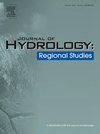量化生态系统-人类水资源权衡:清洁水资源短缺的视角
IF 5
2区 地球科学
Q1 WATER RESOURCES
引用次数: 0
摘要
研究区域:长江流域。研究重点:水安全是发展中国家和发达国家长期关注的问题,它对用于识别和获取水资源短缺的方法的可靠性提出了严格的标准。以往的水资源短缺评估方法主要关注人类用水的数量和质量需求,低估了生态系统需水量的时空波动和生态水资源短缺的影响。本文提出了一种综合生态系统需求和人类需求变化来估算清洁水压力指数的新方法。计算了长江流域的清洁水压力指数(CWSI),并对不同类型的水资源短缺进行了区分。结果表明:2010 ~ 2020年,流域水资源综合指数呈上升趋势,上游地区水资源综合指数严重不足;近9.52% %的网格单元受到生态缺水的威胁。环境流量需求的增加加剧了清洁水的稀缺,且在时空维度上分布不均匀。加权泰尔指数从2010年的0.283上升到2020年的0.417。情景模拟表明,干水胁迫指数的变化主要受自然因素驱动,人类活动起次要作用。我们的方法为阐明生态系统和人类对水安全的影响提供了一个新的视角。本文章由计算机程序翻译,如有差异,请以英文原文为准。
Quantifying ecosystem-human water trade-offs: A clean water scarcity perspective
Study region
Yangtze River basin.
Study focus
Water security is a long-standing concern in developing and developed countries, putting rigorous standards on the reliability of approaches applied to identity and access water scarcity. Previous methods for assessing water scarcity have primarily focused on the quantitative and qualitative needs of human water consumption, underestimating the spatiotemporal fluctuation in water demand of ecosystems and the impacts of ecological water scarcity. Here, we introduce a novel approach to estimate clean water stress index by integrating changes in ecosystem requirement and human demand.
New hydrological insights for the region
We calculated clean water stress index (CWSI) and distinguished different types of water scarcity in the Yangtze River basin. Results indicate an upward tendency in CWSI from 2010 to 2020, with severe deficiencies occurred in upstream regions. Nearly 9.52 % of grid cells were threatened by ecology-based water scarcity. The increase in environmental flow requirement exacerbated clean water scarcity, which was unevenly distributed across temporal and spatial dimensions. The weighted Theil’s index increased from 0.283 in 2010–0.417 in 2020. Scenario simulations show that the variations of clean water stress index were predominantly driven by natural factor, while human activity assumed a secondary role. Our proposed approach provides a novel perspective for elucidating the impacts of ecosystem and human on water security.
求助全文
通过发布文献求助,成功后即可免费获取论文全文。
去求助
来源期刊

Journal of Hydrology-Regional Studies
Earth and Planetary Sciences-Earth and Planetary Sciences (miscellaneous)
CiteScore
6.70
自引率
8.50%
发文量
284
审稿时长
60 days
期刊介绍:
Journal of Hydrology: Regional Studies publishes original research papers enhancing the science of hydrology and aiming at region-specific problems, past and future conditions, analysis, review and solutions. The journal particularly welcomes research papers that deliver new insights into region-specific hydrological processes and responses to changing conditions, as well as contributions that incorporate interdisciplinarity and translational science.
 求助内容:
求助内容: 应助结果提醒方式:
应助结果提醒方式:


